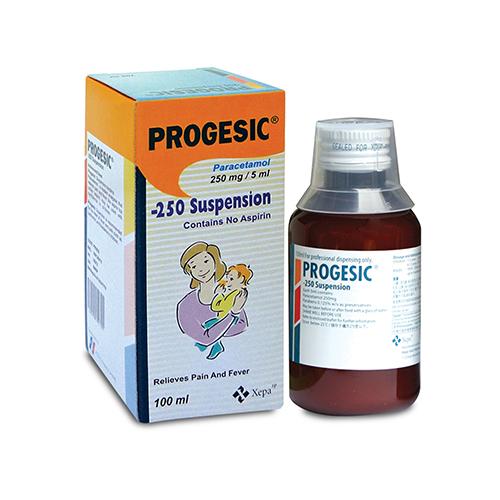
PROGESIC Suspension
Therapeutic Class
Nonsteroidal Anti-Inflammatory Drugs (NSAIDs)
Indications
Progesic Suspension contains paracetamol - a modern analgesic that relieves pain and fever like aspirin but unlike aspirin may be used with confidence in children. Progesic Suspension is recommended for the relief of fever and pain such as toothache, and headache in children.
Chemical Composition
Each 5 ml contains Paracetamol B.P. 250 mg
Packaging
100 ml / Bot
Dosage & Administration
Dosage and Administration Children 1 - 5 years 2.5 ml - 5 ml every four to six hours; 6 - 12 years 5 ml - 10 ml every four to six hours. Adults 10 ml - 20 ml every four to six hours, up to a maximum of 80ml a day. Progesic Suspension may be taken before or after food with a glass of water. Do not exceed the stated dose. If fever does not subside in 36 hours, a doctor should be consulted.
Contraindications
Like other paracetamol preparations, Progesic Suspension should not be used in patients who have shown hypersensitivity to Paracetamol.
Warning & Precautions
This preparation contains PARACETAMOL. Do not take any other paracetamol at the same time. Like other paracetamol preparations, Progesic Suspension should be used with caution in patients with kidney or liver disease. There is potential for liver toxicity and severe liver damage. Do not take more than the recommended dose. Allergy alert Paracetamol may cause severe skin reactions. Symptoms may include skin reddening, blisters or rash. These could be signs of a serious condition. If these reactions occur, stop use and seek medical assistance right away. Serious skin reactions Rarely, paracetamol may cause serious skin reactions such as acute generalised exanthematous pustulosis (AGEP), Stevens-Johnson Syndrome (SJS), and toxic epidermal necrolysis (TEN), which can be fatal. Patients should be informed about the signs of serious skin reactions, and use of the drug should be discontinued at the first appearance of skin rash or any other sign of hypersensitivity.
Side Effects
Progesic Suspension is usually well tolerated. However, if rashes occur, treatment should be discontinued. Cutaneous hypersensitivity reactions including skin rashes, angioedema, Stevens Johnson Syndrome/Toxic Epidermal Necrolysis have been reported.

